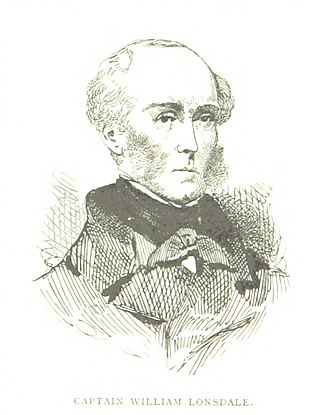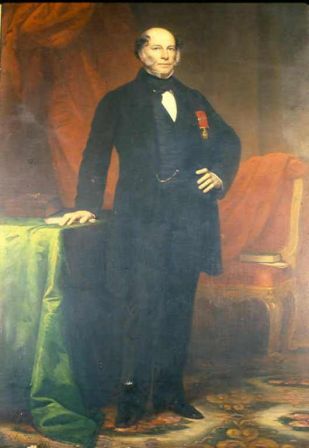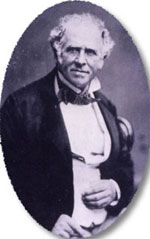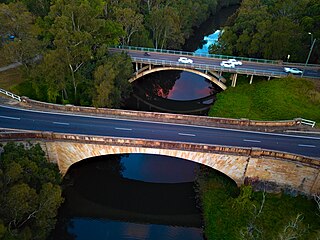
Darlinghurst is an inner-city, suburb in the eastern suburbs of Sydney, New South Wales, Australia. Darlinghurst is located immediately east of the Sydney central business district (CBD) and Hyde Park, within the local government area of the City of Sydney. It is often colloquially referred to as "Darlo".

General Sir Richard Bourke, KCB, was an Irish soldier, who served in the British Army and was Governor of New South Wales from 1831 to 1837. As a lifelong Whig (Liberal), he encouraged the emancipation of convicts and helped bring forward the ending of penal transportation to Australia. In this, he faced strong opposition from the landlord establishment and its press. He approved a new settlement on the Yarra River, and named it Melbourne, in honour of the incumbent British prime minister, Lord Melbourne.

Sir Robert Richard Torrens,, also known as Robert Richard Chute Torrens, was an Irish-born parliamentarian, writer, and land reformer. After a move to London in 1836, he became prominent in the early years of the Colony of South Australia, emigrating after being appointed to a civil service position there in 1840. He was Colonial Treasurer and Registrar-General from 1852 to 1857 and then the third Premier of South Australia for a single month in September 1857.
The history of Australia from 1788 to 1850 covers the early British colonial period of Australia's history. This started with the arrival in 1788 of the First Fleet of British ships at Port Jackson on the lands of the Eora, and the establishment of the penal colony of New South Wales as part of the British Empire. It further covers the European scientific exploration of the continent and the establishment of the other Australian colonies that make up the modern states of Australia.

The Sydney Church of England Grammar School is a dual-campus independent Anglican single-sex and co-educational early learning, primary and secondary day and boarding school for boys, located on the Lower North Shore of Sydney, New South Wales, Australia.

John Hubert Plunkett was Attorney-General of New South Wales, an appointed member of the Legislative Council 1836–41, 1843–56, 1857–58 and 1861–69. He was also elected as a member of the Legislative Assembly 1856–60. He is best known for the prosecution of the colonists who brutally murdered 28 Aboriginals in the Myall Creek Massacre of 1838, seven of whom were convicted and hanged.

William Lonsdale supervised the founding of the official settlement at Port Phillip from 1836 and went on to serve under the Superintendent La Trobe from 1839 to 1854.

Sir Edward Deas Thomson was a Scotsman who became an administrator and politician in Australia, and was chancellor of the University of Sydney.

Lieutenant Colonel George Barney was a military engineer of the Corps of Royal Engineers and became Lieutenant Governor of the Colony of North Australia.
The following lists events that happened during 1836 in Australia.
James Mudie (1779–1852) was a Scottish-born free settler of Australia who became an officer of marines, large landowner, and author.
The following lists events that happened during 1836 in New Zealand.

Mortimer William Lewis was an English-born architect, surveyor and public servant who migrated to Australia and became Colonial Architect in the colony of New South Wales from 1835 to 1849. Lewis was responsible for designing and overseeing many government buildings in Sydney and rural New South Wales, many of which are heritage listed.

Charles Hotson Ebden was an Australian pastoralist and politician, a member of the New South Wales Legislative Council, the Victorian Legislative Council and the Victorian Legislative Assembly.

Sir Patrick Lindesay, was a Scottish military officer during the Napoleonic Wars and Peninsular War but is most noted as having served as Acting Governor of New South Wales, Australia in 1831. Mount Lindesay (Queensland), Mount Lindesay, and Lindesay River in Australia are all named after him.

Solicitor General for New South Wales, known informally as the Solicitor General, is one of the Law Officers of the Crown, and the deputy of the Attorney General. They can exercise the powers of the Attorney General in the Attorney General's absence. The Solicitor General acts alongside the Crown Advocate, and Crown Solicitor, and serves as one of the legal and constitutional advisers of the Crown and its government in the Australian state of New South Wales.
Members of the New South Wales Legislative Council who served from 1861 to 1864 were appointed for life by the Governor on the advice of the Premier. The 1855 Constitution of New South Wales provided that the first council was appointed for a period of 5 years, but that subsequent members would be appointed for life. The previous council had ended in controversy with an attempt was made to swamp the chamber by appointing 21 new members in May 1861, because the council had rejected the Robertson land bills. When the council met and the new members were waiting to be sworn in, the President Sir William Burton stated that he felt he had been treated with discourtesy in the matter, resigned his office of president and his membership, and left the chamber. 19 other members also resigned in protest. In the absence of the President and Chairman of Committees, under the standing orders the council was adjourned. There were no further sitting days before the terms of the members of council had expired.

William John Dumaresq was an English-born military officer, civil engineer, landholder and early Australian politician. He is associated with settler colonisation of the areas around Scone and Armidale, in New South Wales.

The Lansdowne Bridge is a heritage-listed road bridge that carries the northbound carriageway of the Hume Highway across Prospect Creek between Lansvale and Lansdowne. Situated in southwestern Sydney it is located on the boundary of the Fairfield and Canterbury-Bankstown local government areas. The bridge was named in honour of Henry Petty-Fitzmaurice, 3rd Marquess of Lansdowne (1780–1863), an Irish Whig politician of the British Parliament and associate of the NSW Governor of the day, Sir Richard Bourke.
Lieutenant George Meares Countess Bowen (1803–1889) was a military officer and colonial settler of New South Wales, Australia. He was mainly associated with Bowen Mountain, Mount Tomah, Berambing, and the nearby areas of the Blue Mountains.














